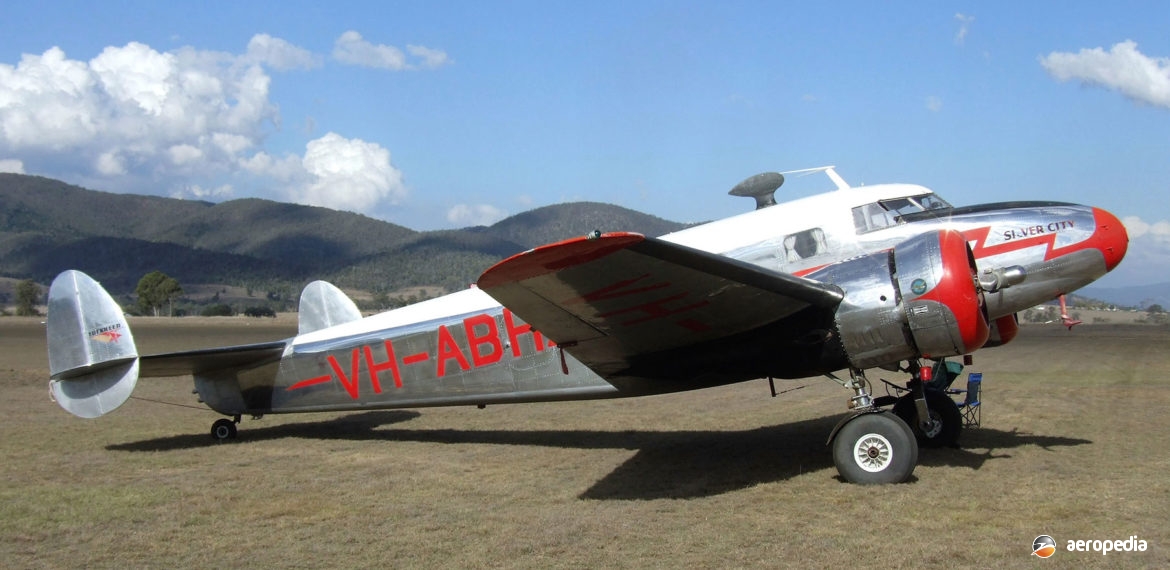Photograph:
Lockheed 12A VH-ABH (c/n 1236)at Watts Bridge, QLD in August 2006 (David C Eyre)
Country of origin:
United States of America
Description:
Commercial airliner
Power Plant:
Two 336 kw (450 hp) Pratt & Whitney Wasp Junior SB-2 nine-cylinder air-cooled radial engines
Specifications:
- Wingspan: 15.1 m (49 ft 6 in)
- Length: 11.1 m (36 ft 4 in)
- Height: 3 m (9 ft 9 in)
- Wing area: 32.8 m² (352 sq ft)
- Max speed at 1,524 m (5,000 ft): 362 km/h (225 mph)
- Max speed at sea level: 344 km/h (214 mph)
- Cruising speed at 1,524 m (5,000 ft): 325 km/h (202 mph)
- Cruising speed at 2,926 m (9,600 ft): 341 km/h (212 mph)
- Initial rate of climb: 426 m/min (1,400 ft/min)
- Landing speed: 105 km/h (65 mph)
- Service ceiling: 6,797 m (22,300 ft)
- Range at 50% power: 1,706 m (1,060 miles)
- Empty weight: 2,700 kg (5,960 lb)
- Loaded weight: 4,173 kg (9.200 lb)
History:
In 1935 the Lockheed Aircraft Corporation decided to build a smaller version of its very successful Model 10 for feeder-line and business use. Similar to the Model 10, but with three cabin windows on each side, smaller overall dimensions, and Wasp Junior engines, the Model 12 was flown for the first time on 27 June 1935. A total of 114 examples had been built by the time production ceased in 1942 so that the company could devote its facilities to the production of military aircraft for World War II.
Two main variants of the Model 12 were built, the 12A and 12B. Early production Model 12As were powered by two 298 kw (400 hp) Pratt & Whitney Wasp Junior SB engines, but later production aircraft were fitted with the SB-2 engine giving 336 kw (450 hp). The Model 12B was fitted with two 313 kw (420 hp) Wright Whirlwind R-975-E3 engines. When first produced the Model 12 was the fastest commercial airliner of its type produced in the USA, and a military derivative, known as the Model 212-A, fitted with a dorsal gun turret, was supplied to the Netherlands East Indies and other countries.
The Netherlands East Indies Government was the largest operator of the Model 12, operating two variants known as the L-12 and L-212, some 36 examples (serials L2-1 to L2-36) being ordered in 1938 for operation as bomber crew trainers. Serial L-201 was first flown on 7 March 1939 and by 1 June that year aircraft c/ns 212-001 to 212-010 had been shipped, the first five arriving at Surabaya, Java in June, some 16 having been delivered by June 1940. These aircraft were fitted with a dorsal turret. A few were soon destroyed by advancing Japanese forces. One (serial L2-27) escaped from Java to Ceylon where it was taken over by the RAF. Others were not shipped and were used to form the Dutch Military Flying School at Jackson Field in the United States where training of Dutch crews was transferred.
It would appear at least five ex NEIAF aircraft came to Australia, these being serials L2-27, L2-31, L2-33, L2-34 and L2-35, three being assigned to the Militaire Luchtvaat at Laverton, VIC, and two being assigned to the USAAF (L2-31 and L2-33). Two were on board ships re-routed to Australia and these were taken over by the USAAC and used as part of the ADAT fleet. The other was used by Dutch forces in Australia, eventually becoming VH-ASG (c/n 1302 – ex L2-34 – Silver Gull) on 9 December 1946. It was operated by Associated Airlines until exported to Malaysia in December 1963 as 9M-ANK, eventually crashing at Bukit Besi on 16 October 1966.
After closure of the training operations in the United States, seven of the eleven Model 12s used were shipped to Australia where they joined the NEIAF units operating here. However, little is known of their later operations. It is known eight were operated by Nos 18 and 122 Squadrons, RAAF using VH call signs. One ex L2-41 (c/n 1309), later L2-104, operating with the call sign VHRDS, served with Nos 19 and 121 Squadrons, and L2-35 (c/n 1303), using call sign VHRDO, was re-serialled T-310 later in the War.

